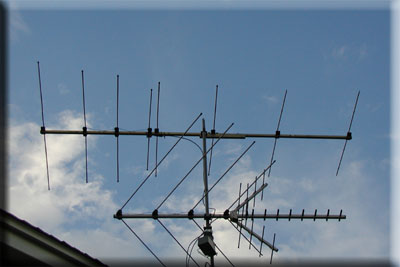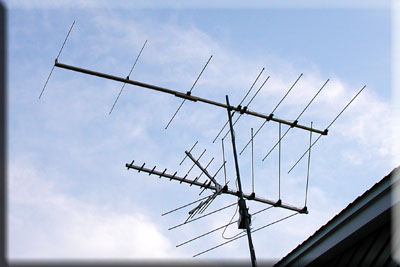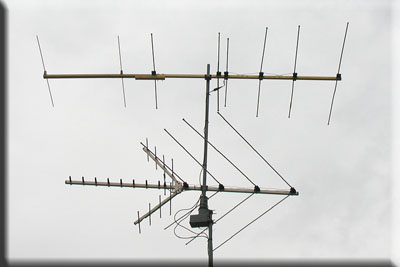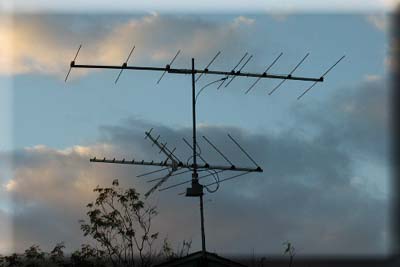Radio Shack 6-element FM Yagi Hacking
I had some fun along the way!
I've been experimenting with various element configurations since 2004. I do not own computer antenna simulation software or spectrum analyzers to make precise measurements. I just make a change and throw the antenna back up in the air to see what effects it has. A good pattern is better than squeezing out gain. Luckily, nearly all of the powerful stations lie within 15 degrees on the compass so I get blasted from just one direction.
2006 experiementation

I took two 6-element antenna's and made better one with eight. I should have done this long ago because the performance is a little better than with the wood boom discussed below. I apparently have an old version of the antenna because the last director length is 48 inches instead of the 50 inches in the current version. I purchased the antennas back in the mid 1980's. I also tried nine elements but it turns out eight works better.
- Drilled out the rusty rivets from one antenna and removed all the elements. I cut 20 inches off the boom to use as support for the extention. Now the boom is 120 inches.
- Trimmed two of the elements down to 47 and 45 inches.
- Placed a 48 inch element 21.5 inches from the first director. Placed a 47 inch element at 25 inches from the previous. The last one is at the end of the boom which is 29 inches from the previous.
- Made and installed an inductor across the feedpoint per K6STI's suggestion here
I am happy with the performance. Here are some of the characteristics:
- Gain is good throughout the band. Although there is compromise between that and a better pattern.
- Nice low band null 180 degrees from about 90MHz to 96MHz.
- Great 90 degree nulls throughout the band.
- Deep 60 degree nulls from about 104MHz and up.
- The backlobe is much improved over the original.

Previous experimental musings
My disclaimer: I cannot make any comparisons to any commercial antenna designs but the stock 6-element yagi. I've never used anything but this antenna. All I know is I have improved on the stock Radio Shack antenna.
Materials:
Pine and oak 1.5" by 1" boards.
Screws
¼ inch aluminum rods
Balun is an old Radio Shack one with 4 inch lead extensions soldered on. This seems to provide for better signal transfer from the antenna to the feedline.
Where the boom is attached to the mast was moved to make the antenna more balanced. The mounting point on the stock antenna would make it very front heavy with the extra wood and elements.
Situation: I live in a high signal area with 350,000 watts of RF on about a 10 degree wide angle on a southeast vector. The stations are all located from 7 to 14 miles away with a 175,000 flamethrower and five 22,000 watt class Bs 8 miles away. This wipes out most DX from the southeast direction from the front end overload.
Goal: I want to hear the best quality audio my tuner can provide from the local stations and listen to stations from other markets like Dayton, Cincinnati and Cleveland.
Equipment: Yamaha RX-V870 AV receiver, antenna on a rotator 25 feet above ground.
1) Adding a 46 inch wide ¼ aluminum element 27 inches out from the front director. It helped forward gain slightly and reduced the size of the backlobe sligthly. I was just getting started. Boom length 97 inches.
2) I found a performance review of this widely available antenna here (RS 6-element modeled). This design does two things differently. It adds 46 inch element 33.25" forward of the first stock director and it calls for an element diameter of 3/8 inches which is thicker than what I used. Backlobe improved and gain went up just a tad.
3) Next came a two element augmentation. I added an element 27 inches and another 57 inches in front of the first director. This design worked very well. The back lobe had a pretty good null at 180 degrees in the lower part of the band. In the upper part of the band, the back lobe smaller. Boom length was 127 inches.

4) Shorter configuration: I moved the elements to 15 and 40 inches from the stock director. It retained some of the desirable pattern characteristics #3 had. Gain went down a little and the back lobe was bigger. Boom length is 110 inches.
5) One last try on the two element configuration. I retained the same length of boom at #4 but I moved the inner director 3 inches closer to the stock director. This created a pattern that is quite similar to the 127" design in #3. The response throughout the band is uneven though. The backlobe changes quite a bit with frequency.

6) 2005 experimentation: I changed the elements from 1/4 inch to 3/8 inch. I drilled out the mounting rivet and moved the smallest director back to 13 inches from the one next to the driven element. Then I placed three directors with the spacing 19.5, 21 and 24 inches apart on each successive element. They have the lengths of 46.5, 43 and 40 inches respectively. This antenna exhibits a much smoother pattern response than 2004's experimentation. The gain is very good with it favoring the upper part of the band. The backlobe is better than the 2004 designs and it has some great 90 degree side nulls to knock down the locals as much as possible.

Edited May 2006




